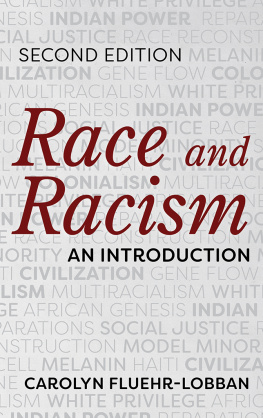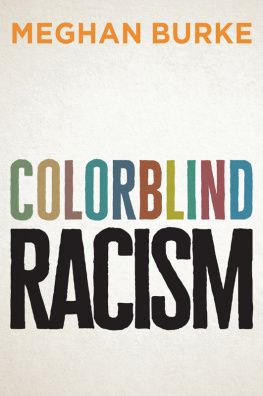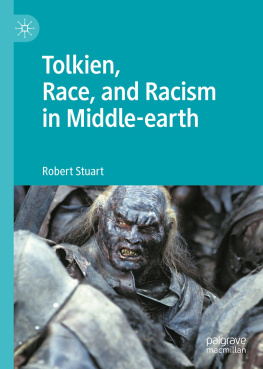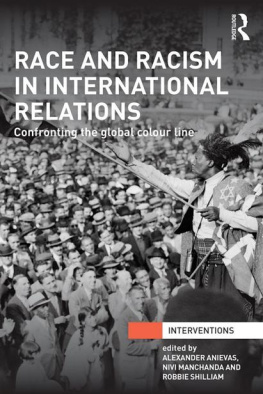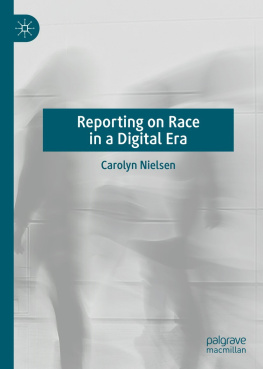Carolyn Fluehr-Lobban - Race and Racism
Here you can read online Carolyn Fluehr-Lobban - Race and Racism full text of the book (entire story) in english for free. Download pdf and epub, get meaning, cover and reviews about this ebook. year: 2018, genre: Politics. Description of the work, (preface) as well as reviews are available. Best literature library LitArk.com created for fans of good reading and offers a wide selection of genres:
Romance novel
Science fiction
Adventure
Detective
Science
History
Home and family
Prose
Art
Politics
Computer
Non-fiction
Religion
Business
Children
Humor
Choose a favorite category and find really read worthwhile books. Enjoy immersion in the world of imagination, feel the emotions of the characters or learn something new for yourself, make an fascinating discovery.
- Book:Race and Racism
- Author:
- Genre:
- Year:2018
- Rating:3 / 5
- Favourites:Add to favourites
- Your mark:
- 60
- 1
- 2
- 3
- 4
- 5
Race and Racism: summary, description and annotation
We offer to read an annotation, description, summary or preface (depends on what the author of the book "Race and Racism" wrote himself). If you haven't found the necessary information about the book — write in the comments, we will try to find it.
Race and Racism — read online for free the complete book (whole text) full work
Below is the text of the book, divided by pages. System saving the place of the last page read, allows you to conveniently read the book "Race and Racism" online for free, without having to search again every time where you left off. Put a bookmark, and you can go to the page where you finished reading at any time.
Font size:
Interval:
Bookmark:

Second Edition
Race and Racism
An Introduction
Carolyn Fluehr-Lobban
Professor Emerita of Anthropology
Rhode Island College
ROWMAN & LITTLEFIELD
Lanham Boulder New York London
Executive Editor: Nancy Roberts
Assistant Editor: Megan Manzano
Senior Marketing Manager: Kim Lyons
Interior Designer: Ilze Lemesis
Cover Designer: Dustin Watson
Credits and acknowledgments borrowed from other sources and reproduced, with permission, in this textbook appear on the appropriate page within the text.
Published by Rowman & Littlefield
An imprint of The Rowman & Littlefield Publishing Group, Inc.
4501 Forbes Boulevard, Suite 200, Lanham, Maryland 20706
www.rowman.com
Unit A, Whitacre Mews, 26-34 Stannary Street, London SE11 4AB, United Kingdom
Copyright 2019 by The Rowman & Littlefield Publishing Group, Inc.
All rights reserved . No part of this book may be reproduced in any form or by any electronic or mechanical means, including information storage and retrieval systems, without written permission from the publisher, except by a reviewer who may quote passages in a review.
British Library Cataloguing in Publication Information Available
Library of Congress Cataloging-in-Publication Data
Names: Fluehr-Lobban, Carolyn, author.
Title: Race and racism : an introduction / Carolyn Fluehr-Lobban, Emerita, Rhode Island College.
Description: Second edition. | Lanham : Rowman & Littlefield, 2019. |
Includes bibliographical references and index.
Identifiers: LCCN 2017057238 (print) | LCCN 2017060401 (ebook) | ISBN
9781442274600 (electronic) | ISBN 9781442274587 (cloth : alk. paper) |
ISBN 9781442274594 (pbk. : alk. paper)
Subjects: LCSH: AnthropologyUnited StatesHistory. | Physical
anthropologyUnited StatesHistory. | Racism in anthropologyUnited
StatesHistory. | WhitesRace identityUnited StatesHistory. |
RacismUnited StatesHistory. | United StatesRace relations.
Classification: LCC GN17.3.U6 (ebook) | LCC GN17.3.U6 F58 2019 (print) | DDC
305.800973dc23
LC record available at https://lccn.loc.gov/2017057238
 The paper used in this publication meets the minimum requirements of American National Standard for Information SciencesPermanence of Paper for Printed Library Materials, ANSI/NISO Z39.48-1992.
The paper used in this publication meets the minimum requirements of American National Standard for Information SciencesPermanence of Paper for Printed Library Materials, ANSI/NISO Z39.48-1992.
Printed in the United States of America
Dedication
May the color bar that W. E. B. Du Bois cast as the defining feature of the twentieth century not also define the twenty-first century.
Contents
Contrasting Presidents
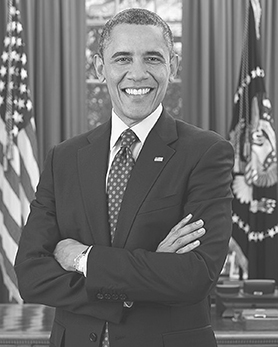
FIGURE 0.1A Barack Obama presidential portrait
Source: Photograph by Pete Souza/Public domain

FIGURE 0.1B Donald Trump presidential portrait
Source: Library of Congress Prints and Photographs Division Washington, DC, 20540 USA
Preface
This book was originally born from a frustration in locating a suitable text for courses in anthropology and race. I searched for an introductory text that would combine a comprehensible, accessible summary of the biologyphysical anthropology of race with the social history of the race concept and its applications in society. Excellent books written by physical anthropologists proved difficult to teach, with students complaining about their scientific remoteness. Excellent studies of the history of the race concept lacked the biological information so important to demythologizing race. The second edition of this book, like the first, seeks to bridge this gap.
For the first edition, I was motivated to create a course that combined the study of racist thought with the evolutionary and biological science of racial difference, as I had not been exposed to the critical study of race in my anthropological training during the 1960s and 1970s. Inspired, I introduced a course into the Rhode Island College (RIC) general education program in 1975 entitled Race and Racism. The course was so well received that it was adopted by the anthropology department as one of its regular offerings in 1978 as Anthropology of Race and Racism. At that time, I made a pedagogical decision to offer the course at the introductory level that students could opt to take as part of their basic undergraduate education. Indeed, many students who were not anthropology majors did select the course, particularly from elementary and secondary education, communications, theater and the arts, as well as others of the social sciences.
New to this Edition
A revised introduction to the subject to reflect changes in the United States and the world since 2006, and a personal testimony of a biracial couple regarding their disparate experiences at a state DMV office.
Revised and updated origins of humanity in Africa with latest finds and genetic tracks of the spread of humans out of Africa.
A new section review of recent racist incidents and anti-racist activism.
A new section on objective measures of intelligence, differences by race, and intelligence still fundamentally questioned.
New sections on international perspectives: European cases of France, Germany, and Italy, Can Europe remain white?; the changing New World identity of Afro-Caribbean persons, new contributions by Dominican writers; lessons from South Africas Truth and Reconciliation Commission; and Islamophobia as a subset of racism
New sections on race in America, Donald Trumps electoral victory; Black Lives Still Do Not Matter; Reasonable Racismthe Bernhard Goetz case and beyond; Dylann Roofs killing of black parishioners in South Carolina; a new section on Hollywood and race by Andrew Stewart; a successful suit by the Southern Poverty Law Center against the KKK; and an expanded section on Asian Americans
A frequent comment made at the end of the introductory Anthropology of Race and Racism class was But I feel as though were just getting started, I wish the course could go on for another semester. In response to student interest, I developed an advanced undergraduate and graduate course for our Program of African and Afro-American Studies, entitled Comparative Race Relations, which explored race and racism in our own and in other cultures. In time, this course evolved to one focusing on Critical Race Theory, as advances in fields other than anthropology were taking place in the postcivil rights era in the United States.
Students from the introductory-level courses were recruited not only to the advanced courses but also to involvement in education and civil rights activism. From these courses the RIC Unity Players emerged, a multiracial group of students who performed skits on race and diversity for community, high school, and university audiences.
It was in this context that the pioneering Haitian anthropologist Antnor Firmin was discovered and then recovered in a 1988 Anthropology of Race and Racism class. Firmin was brought to my attention by a Haitian student, Jacques Raphael Georges, who asked if I had not heard of Firmins De lgalit des races humaines: Anthropologie positive , published in Paris in 1885 in response to Arthur Gobineaus writings on the inequality of races in 1855. This rediscovery of Firmin led to an English translation of the book by Haitian scholar Asselin Charles that appeared in hardcover in 2000 and in paperback in 2002 as The Equality of the Human Races: Positivist Anthropology . The first conference on Firmin was held at RIC in 2001, and Dr. Cary Hector at Quisqueya University in Port-au-Prince organized a conference celebrating the 150th anniversary of Firmins birth in 2011. Since the English edition, two new French editions have been published, one to coincide with the bicentennial of Haitian independence from France.
Font size:
Interval:
Bookmark:
Similar books «Race and Racism»
Look at similar books to Race and Racism. We have selected literature similar in name and meaning in the hope of providing readers with more options to find new, interesting, not yet read works.
Discussion, reviews of the book Race and Racism and just readers' own opinions. Leave your comments, write what you think about the work, its meaning or the main characters. Specify what exactly you liked and what you didn't like, and why you think so.

